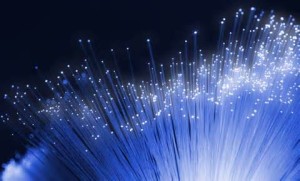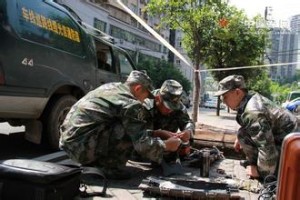HOW To choose the right fiber optic cable for your fiber optic network?
Background of fibe roptic nework
The fundamental difference between a fiber optic communication system and other types is that signals are transmitted as light. Conventional electronic communication relies on electrons passing through cables. Microwave communication relies on microwaves travelling through open space. High transmission capacity and long transmission distance are two major advantages of fiber optics compared with metal cables. However, different factors can dictate the choice of fiber for other applications. The wide variety of fiber optic systems have led to many applications and some of them are:
- Connections between chips and circuits in computers (which will be the main aspect of this project).
- Links among computers used for purposes such as computer aided design.
- Local Area Networks operating at speeds too high or over distances too long for the use of metal cables.
- High speed interconnections between computers and peripheral devices, or between computers.
- Transmission for difficult environments, especially those plagued with electromagnetic interference.
These are a few of the current fiber optic applications. More are sure to come as technology develops. The main application that will be dealt with in this project is fiber optic connections within computers.
Compared with copper network, fiber optic cable is less expensive, and consume less metal, beside it. fiber optic without immunity to electromagnetic interference, with good data security, people not easy to theft the data, non conductive. eliminating spark hazards, ease of installation High bandwidth over long distance. Thus, Fiber optic cable is a good choice for today’s high-speed data communications. While, It is little bit difficult for beginners to make the right decisions to choose the right fiber optic cable, single mode or multi mode, indoor cable or outdoor cable, Loose tube cable, or OPGW cable, etc. with the topic, we will go through information about fiber to help you choose the right fiber optic cable for FTTH network, data transmission network, CATV network or other network.
Introduction to SM and MM fiber optic cable
There are to fiber optic cable, SM and MM fiber optic cable. Both types consist of two basic components: the core (Generally 9um for SM Cable, 50 or 62.5um for MM cable) and the cladding (Both are 125um) which traps the light in the core. and SM is for Long term transmission, wile MM for short term transmission, generally the distance not over 2km.
1. Single-mode fiber optic cable

Single-mode (SM) fiber optic cables offer a higher transmission rate. These cables contain a tiny core that measures about five to ten microns. These tiny cores have the capacity to eliminate distortion and produce the highest transmission speeds. Single-mode fiber generally has a core that is 8.3 microns in diameter. Singlemode fiber requires laser technology for sending and receiving data. Although a laser is used, light in a single-mode fiber also refracts off the fiber cladding. The presence of high intensity lasers helps transfer data across large distances. Singlemode has the ability to carry a signal for miles.
2. Multimode fiber optic cable
Multimode (MM) fiber, as the name suggests, permits the signal to travel in multiple modes, or pathways, along the inside of the glass strand or core. It is available with fiber core diameters of 62.5 and a slightly smaller 50 microns. The problem with multimode fiber optics is that long cable runs in multiple paths may lead to signal distortion. This can result in incomplete and unclear data transmission.
Which one should i use, SM fiber cable or MM fiber Cable
Single mode is used for long haul or extreme bandwidth applications, gives you a higher transmission rate and up to 50 times more distance than multimode, but it also costs more. The small core and its single lightwave virtually eliminate any distortion that could result from overlapping light pulses, providing the least signal attenuation and highest transmission speeds of any fiber optic cable type.
Applications covering short distances can use multimode fiber optic network cable. Ideal uses for such kinds of cables are within data center connections. Multimode cables are economical choices for such applications. There are various performance levels within the multimode fiber optic cable such as OM3 cable for distances within 300 m, OM4 cable supports Gigabit Ethernet distances within 550m and 10G applications.
The best choice to choose multimode optical cable when the transmission distance is less than 2km. In the other sides, use single-mode optical cable when the transmission is more than 2km. Although the core sizes of multimode and singlemode fiber differ, after the cladding and another layer for durability are applied, both fiber types end up with an outer diameter of about 250 microns. This makes it both more robust and easier to work with.
Indoor Cable Or Outdoor Cable
The major difference between indoor and outdoor cables is water blocking. Any conduit is someday likely to get moisture in it. Outdoor cables are designed to protect the fibers from years of exposure to moisture.
Indoor Cables
Indoor cables are what we call “tight-buffered” cables, where the glass fiber has a primary coating and secondary buffer coatings that enlarge each fiber to 900 microns—about 1mm or 1/25-inch—to make the fiber easier to work with. Indoor cables are flexible, and tough, containing multiple Tight Buffered or Unit Cord fibers.
Types Of Indoor cables available
There are multiple of indoor cable: Simplex and Zip Cord, Distribution cables, Breakout cables
Simplex and Zip Cord: Simplex Fiber Optic Cables are one fiber, tight-buffered (coated with a 900 micron buffer over the primary buffer coating) with Kevlar (aramid fiber) strength members and jacketed for indoor use. The jacket is usually 3mm (1/8 in.) diameter. Zipcord is simply two of these joined with a thin web. It’s used mostly for patch cord and backplane applications, but zipcord can also be used for desktop connections. They are commonly used in patch cord and backplane applications. Additionally, they can be utilized for desktop connections. These cables only have one fiber and are generally used indoors.
Distribution cables: They contain several tight-buffered fibers bundled under the same jacket with Kevlar strength members and sometimes fiberglass rod reinforcement to stiffen the cable and prevent kinking. These cables are small in size, and used for short, dry conduit runs, riser and plenum applications. The fibers are double buffered and can be directly terminated, but because their fibers are not individually reinforced, these cables need to be broken out with a “breakout box” or terminated inside a patch panel or junction box. The distribution cable is smaller and used in dry and short conduit runs, plenum and riser applications, is the most popular cable for indoor use.
Breakout cables: They are made of several simplex cables bundled together inside a common jacket for convenience in pulling and ruggedness. This is a strong, rugged design, but is larger and more expensive than the distribution cables. It is suitable for conduit runs, riser and plenum applications, is ideal for industrial applications where ruggedness is important or in a location where only one or two pieces of equipment (such as local hubs) need to be connected.
Outdoor Cables
Optical fiber in outdoor applications requires more protection from water ingress, vermin, and other conditions encountered underground. Outdoor cables also need increased strength for greater pulling distances. Buyers should know the potential hazards that the cables will face, for example, if the cables will be exposed to chemicals or extreme temperatures.

Loose Tube Fiber Optic cables: These cables are composed of several fibers together inside a small plastic tube, which are in turn wound around a central strength member and jacketed, providing a small, high fiber count cable. This type of cable is ideal for outside plant trunking applications, as it can be made with loose tubes filled with gel or water absorbent powder to prevent harm to the fibers from water. Since the fibers have only a thin buffer coating, they must be carefully handled and protected to prevent damage. It can be used in conduits, strung overhead or buried directly into the ground.
Ribbon Fiber Optic Cable: This cable offers the highest packing density, since all the fibers are laid out in rows, typically of 12 fibers, and laid on top of each other. This way 144 fibers only has a cross section of about 1/4 inch or 6mm! Some cable designs use a “slotted core” with up to 6 of these 144 fiber ribbon assemblies for 864 fibers in one cable! Since it’s outside plant cable, it’s gel-filled for water blocking.
Armored Fiber Optic Cable: Cable installed by direct burial in areas where rodents are a problem usually have metal armored between two jackets to prevent rodent penetration. This means the cable is conductive, so it must be grounded properly. You’d better choose armored fiber optic cable when use cable directly buried outdoor.
Aerial Fiber Optic Cable: They can be lashed to a messenger or another cable (common in CATV) or have metal or aramid strength members to make them self supporting. Aerial cables are for outside installation on poles.
| Cable Type | Application | Advantages |
| Distribution Cable | Premises | Small size for lots of fibers, inexpensive |
| Breakout Cable | Premises | Rugged, easy to terminate, no hardware needed |
| Loose Tube Cable | Outside Plant | Rugged, gel or dry water-blocking |
| Armored Cable | Outside Plant | Prevents rodent damage |
| Ribbon Cable | Outside Plant | Highest fiber count for small size |